Unmanned Aerial Systems
Trajectory Planning of Unmanned Aerial Systems
Unmanned aerial systems may consist of multiple agents with coordinated actions. Modeling and control of the system leads to increasingly complex systems. It is desirable for each agent in the system to reach individual objectives so that the overall objective is accomplished. This problem may be posed as an optimization problem and solved with a receding horizon controller. Solving the problems with APMonitor demonstrates that complex dynamic systems can perform coordinated and optimal actions to achieve a shared objective. This work is performed in collaboration with the BYU MAGICC Lab.

Multiple Agent Control Applications
There are a number of issues associated with multiple agent control that are of interest to other control disciplines as well. For example, in chemical plants and refineries, sophisticated large-scale controllers may be more difficult to maintain than multiple agent-based controllers. Splitting the controller into multiple parts improves the ability to explain controller action, reduces development costs, and allows sub-sets to be revamped without changing the other agents.
